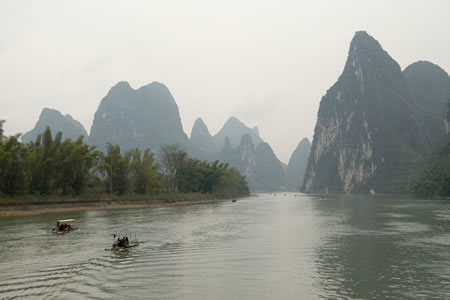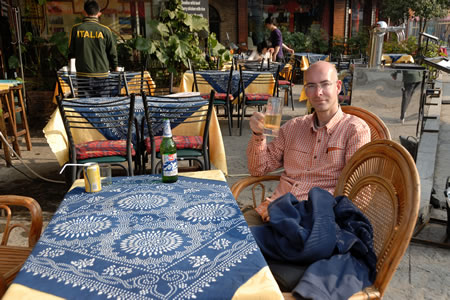English | Dutch |
|
| The year of the tiger | |
Liǔzhōu (China) to Hong Kong (China), Jan-23-10 / Feb-14-10 |
|
If you tell a Chinese that you are planning to visit Guìlín, you will probably receive longing looks of jealously. For most Chinese, but also for many western travellers, Guìlín is a real dream destination. The spectacular karst topography which reaches its climax in this area, is a must see on any visit to the southern part of China. It is by many seen as the most spectacular natural area of the whole country. For this reason, we also decided to travel to this area, located in the province of Guăngxī. The expectations were high. A long and cold train journey brought us initially from Guìyáng to Liŭzhōu. Because it was already late in the afternoon, we spent the night over there and the following morning we took the bus for the final two hours to Guìlín. The city didn’t make much impression on us. It probably also had to do with the fact that it was cold, rainy and foggy, making the visibility low. However, the writer of our guide book definitely visited the city in a better time of the year, because he writes poetically about the city: “Otherworldly karst topography provides a stunning backdrop to a city set alongside the tranquil Li River and dotted with scenic lakes, while many of the streets are lined with Osmanthus trees filling the air with a sweet fragrance not normally associated with Chinese cities”. Our impression of the city is quite different. The sights are overrated and definitely overpriced. Some natural sights are even fenced of with plastic, to prevent that you can see it without paying the admission fee. It didn’t take long to decide to travel further to the small town of Yángshuò, which is a much better place to use as a base for exploring the karst area. Most tourists book a Li River boat tour to travel from Guìlín to Yángshuò, because the karst scenery seems to be the best on this stretch. So did we. The tour is very popular, so be prepared to share the river with many other noisy boats. The leaflet of the local tourist authorities even mentions proudly that the harbour from where the tourist boats leave, can handle up to three million visitors a year (approximately 125 big boats a day)! But we were lucky. We travelled outside the tourist season which meant that we shared the river with only a dozen or so other boats. |
|
 |
|
One of the views during the Li River boat tour |
|
| A noisy boat tour is definitely not the prefect and romantic way to enjoy the scenic area, but it is a great way to see how the Chinese enjoy these kinds of tours. And than you notice that their way of enjoying the area is completely different than the way most westerners do. We spent the whole three hours of the journey on the open air upper deck to admire the beautiful area as much as possible, while most Chinese spent most of the time in the boat to play cards, to phone or to enjoy the inclusive lunch. Once in a while, the tour leader of the group, as often armed with a megaphone, instructed the group to go to the outside deck to see one of the karst peaks along the river. Many karst peaks have poetic names like “Nine horse mural hill”, “Dragon head hill” or “Lion riding carp hill”. After the tour guide pointed out the peak, the Chinese immediately started posing, off course not without portraying the peak they are posing with; for instance by imitating a dragon or a lion. It became especially hectic on the deck when we approached the peaks that are also portrayed on the back of the 20 Yuan note. Again, the Chinese started immediately posing, in this case obviously with a 20 Yuan note in their hands (see also the video impression about the area around Yángshuò).
We eventually spent a week in Yángshuò and enjoyed the surrounding area by making several day trips. It isn’t easy to escape the crowds, but we especially enjoyed the hike along the Yulong River. It is a nice day walk to walk from Yángshuò to the Yulong River and subsequently to take a stroll along the river, through the agricultural fields, to the not so spectacular, but more than 600-years old, Dragon Bridge. From there, you can take one of the frequent buses back to Yángshuò. Yángshuò is by the way a friendly little town to relax and to enjoy the variety of food that is on offer, especially when you spent some weeks in rural China. But as mentioned, the place is extremely touristy, so be prepared to meet a lot of touts and other people who all want to earn something from you. We had some sunny days, but most of the days were cloudy and hazy, making the area less picture-perfect. And that is a pity. But it seems that you must be really lucky to see the area in perfect weather, because the haze in this area seems to be as persistent as the touts. |
|
 |
|
After weeks of cold weather, finally a beer on a sunny terrace in Yángshuò |
|
The karst mountains around Guìlín and Yángshuò were the last highlight we really wanted to see during our first visit to China. The remaining days were used to travel to Hong Kong. We initially undertook the 10-hour bus journey to Guăngzhōu (formerly known as Canton) and spend there a full day to get an impression of the city. But this mega city hasn’t a lot on offer for travellers, so after spending one day we decided to travel to the other metropolis of the area: Shēnzhèn. This city seems to be the richest city of China, thanks to the fact that the Chinese government made Shēnzhèn a so called Special Economic Zone. But the city is also one of the least safe cities of China, because the city attracts many poor and low educated migrant workers, all in search for a better life. Shēnzhèn is located within a stone’s throw distance of Hong Kong and is for that reason a perfect stepping stone to that city. Hong Kong is nowadays part of China, but still enjoys a Special Administrative Status (like also Macau). This means that Hong Kong administers itself independently, except for defence en foreign affairs issues. And that means that Hong Kong has some democratic structures and is not hid away behind the Great Chinese Firewall. We are now in Hong Kong for a couple of days, and experienced it so far as a nice, friendly and enjoyable city. It is expensive, but that is something we expected because the Gross Domestic Product per person is around 10% higher than for example in The Netherlands or Canada. Hong Kong is also not so Asiatic anymore as many other cities in the area, like Bangkok, Kuala Lumpur or Jakarta. The western influences are huge and the city could have been also a city in the US or United Kingdom. We are now preparing ourselves for the festivities of the Chinese New Year. Today it is February the 14th, the first day of the year of the Tiger. So far, we didn’t notice any special activities on the streets. But that seems to change later today, when most Hong Kong residents finish their family visits and will flock the streets to enjoy for example the night parade.
|
|
| <Previous weblog> | |